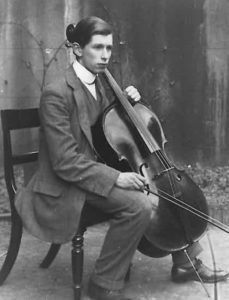
Ambrose Gauntlett c. 1910, by kind permission of David Lea-Wilson © 2017
Although Ambrose Gauntlett (1889–1978) spent most of his career as a full-time orchestral principal, he was the most sought-after continuo cellist and gamba player in the UK for many years. In his obituary, published in The Times, Sir Anthony Lewis mentions “his beautiful playing of the important 18th-century viola da gamba obbligato roles”.
Ambrose was the fifth of ten children and began playing the cello at the age of six. Unusually, he only ever had one teacher, the Belgian Joseph Ernest de Munck, who stayed with him throughout his time as a junior at the Guildhall School of Music, and during his three-year scholarship at the Royal Academy of Music, starting in 1910.
Orchestral highlights
During his first year as a student at the RAM, he joined Sir Thomas Beecham’s opera orchestra at Covent Garden. In 1912 he played in the New Queen’s Hall Orchestra under Henry Wood, and for Oscar Hammerstein’s opera season at the New London Opera House as well as for Diaghilev’s Russian Ballet. In 1913 he became principal cellist of the Covent Garden Opera orchestra under Hamilton Harty and stayed there until 1929, apart from the war years.
Please subscribe to this blog – in the top right corner – and receive notifications of new posts by e-mail. In terms of getting information, this is preferable to “liking” the blog (though you can do that too), as Facebook’s money-making system limits the number of people who see our news feed, to as little as 10% of the total sent!
In 1930 he became a founder member of the BBC Symphony Orchestra, as principal under Sir Adrian Boult; he remained in this post until 1947 when, aged 58, he left to go freelance and became professor of cello at the RAM, a post from which he did not retire until he was 75, in 1965.
Early music on BBC radio
Despite his orchestral commitments (which were many more than those mentioned above), Ambrose had started playing on the radio in 1925, as a soloist and in chamber music, largely as part of the Kutcher and Mangeot string quartets.
His first documented foray into early music was in February 1927, when he played the bass part in a series of five radio programmes of Corelli’s violin sonatas with William Primrose, who was later to become famous as a viola player. The edition used was from 1780; according to the programme notes, “This bass part could either be put into shape [using the figuring] by a Harpsichord player or (as we shall hear it this week) by a ‘Cellist.”
He next appears in a broadcast in June 1929 in Bach’s cantata Bleib bei uns, denn es will Abend werden, with the Wireless Choir and Orchestra, playing the violoncello piccolo.
The viola da gamba
Ambrose is first listed as playing the gamba in a radio broadcast of “light classical music” in October 1932, with a group called the English Harpsichord Trio. His good friend James Lockyer, who was the viola player from the Kutcher String Quartet, played the viola d’amore in that performance, with John Ticehurst on the harpsichord.
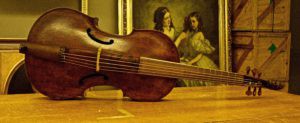
The 1678 Thomas Cole bass viol, by kind permission of the Newberry Library, Chicago © 2017
It’s interesting to note that this was exactly the same combination of instruments for which the Chaplin sisters had become famous. Perhaps following the demise of the Chaplin Trio in 1930, Ambrose saw a gap in the market?
We don’t know why Ambrose took up the gamba; he may have been inspired by hearing Rudolph Dolmetsch (1906–1942), the most talented of Arnold’s children, play the gamba in a radio broadcast in May 1931 of Bach’s cantata Tritt auf die Glaubensbahn, in which he took part, albeit on the cello.
More concerts and broadcasts
Ambrose played early music throughout his very long career, and took part in various ad hoc ensembles and orchestras, with the likes of Desmond Dupré, Charles Spinks, Thurston Dart, Diana Poulton, Julian Bream, Francis Baines, Geraint Jones, Arnold Goldsbrough and Boris Ord.
According to music journalist and author Margaret Campbell, he played in the St Matthew Passion at Westminster Abbey every year for 50 years and for the (London) Bach Choir for more than 30 years; in March 1941 the critic of The Times wrote that Ambrose’s gamba obbligato “must be specially mentioned”.
Apart from Bach’s Passions, he played Bach cantatas with the Geraint Jones Orchestra; Handel opera excerpts with the Boyd Neel Orchestra under Anthony Lewis; Monteverdi’s madrigals, with the Deller Consort. He took the gamba part, at Morley College, in Monteverdi’s 1610 Vespers in 1946 (first British performance) and 1947 and, in 1948, played in L’Incoronazione di Poppea, all of which were conducted by Walter Goehr, with a choir trained by Michael Tippett. He repeated the 1610 Vespers at the Royal Festival Hall in October 1958, with the BBC Symphony Orchestra, hopefully pared down!
On radio, he played the gamba in Purcell’s King Arthur in December 1936 and was involved in several long-running radio series such as “From Plainsong to Purcell”, Gerald Abraham’s “A History in Sound of European Music” and “The Contemporaries of Bach and Handel”.
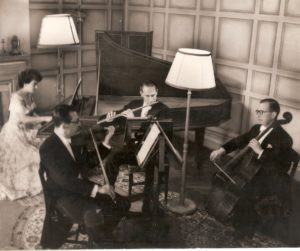
The London Harpsichord Ensemble c. 1950; FLTR Millicent Silver, Peter Mountain, John Francis and Ambrose Gauntlett, by kind permission of Sarah Francis © 2017
From 1948 he performed in more than a hundred radio programmes with the London Harpsichord Ensemble, run by the husband-and-wife team of John Francis (flute) and Millicent Silver (harpsichord), which consisted of several musicians in many different combinations. Although Ambrose played Bach’s gamba sonatas with Millicent Silver in November 1950, most of the ensemble’s repertoire consisted of trio sonatas, solo cantatas and small chamber works by Couperin, Rameau, Buxtehude, Purcell and so on.
Ambrose was a member of the Elizabethan Consort of Viols, founded in 1957 by Dennis Nesbitt (who was also a principal cellist, of the London Symphony Orchestra). Late in his career, he played with the Purcell Consort of Voices, James Bowman (counter-tenor), and Robert Spencer (lute).
Ambrose continued playing until May 1972, when he was 82; his last concert performance was at the Queen Elizabeth Hall, in an orchestra formed to celebrate the 150th anniversary of the Royal Academy of Music.
Recordings
Apart from his lifelong work with various orchestras, Ambrose began recording in 1924 with two records of the songs of M. A. Lucas, with Gladys Marloe and James Lockyer, viola. In 1934 he played the gamba in Purcell’s Golden Sonata with Isolde Menges and William Primrose, violins, and John Ticehurst, harpsichord.
Listen to this recording of Purcell’s Golden Sonata
Ambrose played the obbligato gamba in both the 1948 recording of the St Matthew Passion and the 1952 St John Passion, with the Bach Choir and the London Philharmonic Orchestra conducted by Sir Adrian Boult.
Compare this with Harnoncourt’s 1985 version, with a boy alto and Christophe Coin
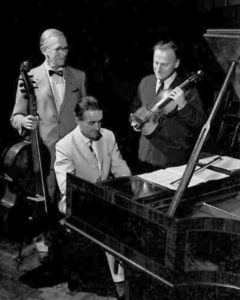
Ambrose with Yehudi Menuhin and George Malcolm c. 1960
Ambrose played the gamba in three of Bach’s six Sonatas for Violin and Harpsichord recorded by Yehudi Menuhin and George Malcolm in 1962; he also took part in Menuhin’s version of Handel’s Op. 1 Violin Sonatas, the Water Music and Bach’s sixth Brandenburg Concerto. He played with Malcolm again in the Bach Flute Sonatas, with Elaine Shaffer, and subsequently made discs of songs with Janet Baker and John Shirley-Quirk.
Instruments
Until 1958, Ambrose owned a 1693 Barak Norman bass viol, which he sold to Dietrich Kessler; this instrument (inventory number 937) is now part of the Kessler Collection at the Royal College of Music Museum.

The 1693 Barak Norman bass viol, by kind permission of the Royal College of Music Museum © 2017.
He kept a 1678 Thomas Cole bass viol until his death, which is now owned by the Newberry Library in Chicago, and used by the Newberry Consort. He also had an undated Barak Norman cello and, at least, another one, by Goffriller (date unknown).
Significance
As with his BBC Symphony Orchestra colleague, Harry Danks (of the London Consort of Viols), playing the gamba and early music in general was only ever a sideline. Nevertheless, Ambrose was described in the obituary in The Musical Times as “a leading exponent [of the viola da gamba], at a time when the instrument was rarely used”; certainly he was one of the very few people who could play the instrument at a professional level, rather than simply being able to hold a part in a consort.
And although he initially set up his gamba with a very high bridge and without frets, and bowed it like a cello – which led Robert Donington to call the instrument a “cellamba”, and comment that Ambrose played “with a musicianship worthy of a better cause” – he was not the only one to do this.
According to John Rutledge, in his articles in the Journal of the Viola da Gamba Society of America, this practice was widespread from the 1880s to the 1950s at least. In fact, Ambrose was in very good company, as the Dutch early music pioneer, Carel van Leeuwen Boomkamp (1906–2000), who taught Anner Bylsma and Gustav Leonhardt, bowed overhand on a seven-string gamba with an end-pin, which had been specially made for him by the Amsterdam violin maker Max Möller, so as to produce a very big sound.
Nikolaus Harnoncourt’s approach was also not always very authentic, as he mentioned in an interview in 2012, speaking about his involvement, with Leonhardt, in Straube’s film Chronicle of Anna Magdalena Bach which was released in 1967. Harnoncourt, who had started the gamba in the late 1940s, said, “I […] immediately changed my way of playing on the gamba for this film, because at that time I held the bow from above, and of course for the film, for historical reasons, I had to hold the bow from underneath, which is how they played in the period.”
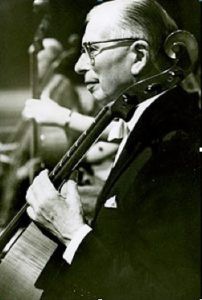
Ambrose in later life, playing an unidentified gamba.
The eminent viol player, Jane Ryan, first heard Ambrose when she was a schoolgirl, at one of the annual Bach Choir performances of the St Matthew Passion, with the Jacques Orchestra, at the Royal Albert Hall after the war, and she still remembers the very beautiful hybrid sound that he made then.
In later years, she got to know Ambrose well and performed with him. She told me that he became more historically informed after playing with Dennis Nesbitt in his Elizabethan Consort of Viols, and she thought that he may even have read Christopher Simpson’s 1659 book The Division Viol.
Acknowledgments
“First Chair Soloists”, an article in The Strad written by Dolmetsch biographer, the late Margaret Campbell, has been an important source. Thanks are due to Nick Cutts and Katharine Richman of the Bach Choir; David Douglass of the Newberry Consort; Sarah Francis; David Lea-Wilson (Ambrose’s grandson) and his family; Thomas MacCracken; Gabriele Rossi Rognoni, Curator, Royal College of Music Museum, and Jane Ryan.
Copyright © 2017 Semibrevity – All Rights Reserved

A very great gambaplayer indeed!
I heard him when I studied in London with dear dr. Thornton Lofthouse
and his playing made a deep impression on me.
Old men forget but great things remain.
prof. dr. Hans van Dijk
emeritus in musicology
He also played on ‘A Recital of English Songs’, one of the first LPs made by John Shirley-Quirk in the 1960s (reissued on CD: Saga Classics EC 3336-2), in Purcell’s solo cantata ‘When night her purple veil’ with Nona Liddell, Ivor McMahon and Martin Isepp.
Ambrose Gauntlett was my mother’s uncle and someone I knew well. He used to visit us in the Chicago area when he would come through on tour. As a choir boy I visited him in 1966 in Ealing and in subsequent years as well. In our correspondence he urged me never to go into music because he termed “very difficult and unreliable work.” It was always such a pleasure to visit him at his house and listen to him play and tell the stories about the backgrounds of his instruments.
I didn’t take his advice by the way and am still working in Chicago as a classical music recordist and record producer. What a good article this is.
Another noteable recording with Ambrose on viola de gamba is of the Bach flute Sonatas with Elaine Shaffer and George Malcolm. One of my favourite all time records.
Ambrose was godfather to my father, Miles Forster. I have just found a photo of his daughter Peggy with my son Stephen Forster, also playing the cello.